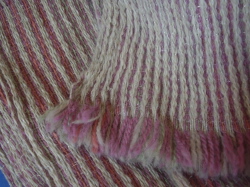The Easter holidays are now over but here you can see some of the photos of the three day complete textile weaving course for beginners here in the Ribeira Sacra (Galicia). We all agreed that a weaving course like this must be one of the most relaxing – and unusual – ways to enjoy the Easter or spring break.


 We kicked off the course with a quick introductory session to weaving on a pre-prepared loom and discover what terms like warp and weft actually mean and how a loom actually works. In less than an hour our novice weavers had surprised themselves by weaving their first piece of cloth, creating their own simple designs and patterns. By the end of the 3 days, we were all talking about warp density, picks, shafts, heddles and weave structure like true professionals!
We kicked off the course with a quick introductory session to weaving on a pre-prepared loom and discover what terms like warp and weft actually mean and how a loom actually works. In less than an hour our novice weavers had surprised themselves by weaving their first piece of cloth, creating their own simple designs and patterns. By the end of the 3 days, we were all talking about warp density, picks, shafts, heddles and weave structure like true professionals!
Then the real work of the course began. Armed with the technical project file the looms were set up with a popular threading, romantically called Rosepath.
Over the next day and a half the warp threads (the group of threads on the loom) were measured and threaded up on the loom. Well done! Not a single error in the pattern threading and only a couple of easy-to-repair errors in the reed threading. This meant we were able to get straight onto the next stage which is always fun – sampling different designs, colours and yarns!
Sampling was the next stage and right from the beginning each person unconsciously started to explore their different personal styles and preferences for pattern, colour and texture. Silk, lambswool and silk-wool mixes were tested out with the gorgeous natural dye colours of the AC Textile Studio.
 When the samples were finished we sat down over coffee to analyse the bits we liked best and to see how different colours, yarns and patterns work and work out the design for the final pieces of work – the scarves.
When the samples were finished we sat down over coffee to analyse the bits we liked best and to see how different colours, yarns and patterns work and work out the design for the final pieces of work – the scarves.

The final proyect under way – pupils work against the clock to weave their own scarf. We decided that weaving was so relaxing we could all have stayed weaving until nightfall – ending up with 4m long scarves!!!


And the final results – Aida and Carmen´s first ever hand-woven scarves. Nice work and I hope you notice the perfect colour co-ordination.
If you weren´t able to come to the Easter course and Aida´s and Carmen´s first scarves make you feel inspired then there is still time to reserve your place on the compact version of the course on the 5/6 of June 2011. The course can be given in Spanish, English or in Spanish with English language support. No previous weaving experience is necessary.
Thanks Aida and Carmen for being such good fun – I hope to see you both again in the summer!
Latest alpaca collapse scarf from Anna Champeney Estudio Textil
I´ve just finished weaving the latest sample design with alpaca and angora yarn combined with a high twist wool and corneta nylon yarn (from the Danish yarn purchasing association). Left – on the loom, before washing, the scarf looks like a classic flat fabric. But right – see what happens with a hot hand-wash; corrugations form which bring out the soft grey with the orchil and cochineal-dyed yarns form a warmly coloured backdrop to the design.

This content is available in:
 Español
Español





